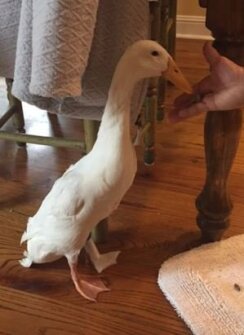A group of small-town Arkansas middle school students made national headlines after they used a 3D printer to make a prosthetic foot for a duck, giving it newfound mobility after it had spent months hobbling around on a stump.
The story, and accompanying videos of Peg the duck are obviously adorable. But the project also speaks volumes about how grounding classroom projects in a sense of purpose and relevance can help motivate students to stay engaged and learn new things. It’s something researchers are increasingly exploring as they search for ways to more thoroughly incorporate students’ emotions and development into education.

Peg, an Indian runner duck who is about 8 months old, was found by a woman who suspected a turtle had chewed off his foot.
Three 8th grade students in the small, unincorporated community of Armorel, Ark., worked all semester to fashion a prosthesis for him. It took 36 prototypes and a lot of failure to get to the exciting moment of seeing Peg walk on the little plastic footing, said Alicia Bell, who teaches the students in a project-based-learning class. But the students—who hadn’t been exposed to 3D printing technology until last year—were willing to persist because they had met a real, living thing that was dependent on their work, Bell said in an interview with Education Week.
Peg, a bit of a ham because he was he was rescued by humans so young, strutted around for the students when they were first introduced. And they noticed that, although he’d been making do without a foot, his stub was scabbed from being scraped on the ground as he walked.
“He’s a living thing, and we got to see his challenges,” Bell said, explaining why the students were so drawn to the project. “He had adapted, but he wasn’t living a full life.”
The students had taught themselves how to use a 3D printer the previous year in the class, called Environmental and Spatial Technology, or EAST lab. The EAST Initiative, founded in Arkansas, provides support and training for schools to offer real-world, technological learning experiences for students. Bell works with community members to find real-world, self-guided projects, like producing videos or designing logos for businesses, that students can complete to help boost their problem-solving skills.
And a sense of purpose and relevance is very motivating to the rural students, many of whom have had little exposure to technology, Bell said. The projects give students opportunities to try and fail, to find new ways to approach challenges, and to learn new concepts, like measuring proportions or using the metric system, she said.

To make Peg’s foot, for example, students had to learn about the specific way that Indian runner ducks stand, rather than squatting with their knees bent at all times like other duck breeds. That meant their original prototype, an actual peg, wouldn’t work because he needed the ability to bend his knee when necessary and the strength to stand with his leg fully extended when walking. Other challenges? Accommodating his back toe and determining the appropriate shape and size needed to help him maintain his balance without encumbering his gait.
“I just ask the questions,” Bell said. “They know they have to fix it. You can’t turn in a paper and, OK, you have a C, and that’s it. It’s either it works or it doesn’t.”
After refining three final prototypes, the students found one that worked. A notch in the front allowed Peg’s knee to bend. And a round surface helped him stay upright.
“They come across a problem, and sometimes it takes a day, or sometimes it takes a month,” Bell said, “but we don’t stop until we figure it out.”
Research backs up Bell’s ideas about the value of purpose in learning. Researchers in the Mindset Scholars Network, a group that explores ideas like the popular concept of growth mindset, say a mindset of “purpose and relevance” is key to students’ perseverance.

“Boredom or frustration are by definition unpleasant,” the organization says in a research brief. “When feeling those emotions, students may ask themselves, ‘Why am I doing this?’ If students have a hard time answering this question, they are less likely to spend the time necessary to try to learn deeply from the material at hand. On the other hand, if a student sees how her school work can help her understand something personally meaningful, she may be more motivated to persist and remain focused despite distractions. When students learn the material more deeply, they can do better in school.”
The joy the students’ project brought to Peg’s owners is evident in this segment produced by Arkansas news station KAIT. As the story quickly spread, the Washington Post, the Associated Press, and USA Today all published news of Peg, and Armorel public schools became his informal press agent Friday afternoon.
KAIT Jonesboro, AR - Region 8 News, weather, sports
Photos by Armorel High School EAST and Patsy Smith. From top to bottom: Peg models his new prosthetic foot; 3D-printed prototypes for the prosthetic; 8th grade students Matthew Cook, Abby Simmons, and Darshan Patel pose with Peg and his owner, Patty Smith.
